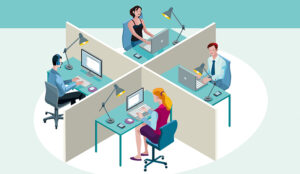Nancy Kirwan of Genesys shares her advice for staying compliant and looking after employee well-being while homeworking.
These days, it seems like everyone has a guide for successful home working, from the Verge to NPR to the Wall Street Journal.
From the IT perspective, successful remote work starts with the technological underpinnings that make it possible. And while we often think of security as something the IT team handles, there are some things we can do from home to help.
Use the company VPN; work on the company-provided software programs; make sure to install all updates when you’re prompted.
These steps might seem obvious, but when’s the last time you changed the password that lets people adjust the setting in your home internet WiFi router?
Cybercriminals know that so many of us are remote — our home networks are their new targets as they seek to steal corporate information.
Being Effective and Staying Sane
Next there are habits that help us succeed. Some experts recommend putting on your normal business clothes, whether that’s a suit or a hoodie and jeans, while others think it’s okay to get comfortable — without showing up for video calls in your pyjamas.
Other experts recommend recreating your normal commute to get you into the right frame of mind, though I can’t figure out how to stretch the walk downstairs into my regular 90-minute morning drive time.
What’s right about this, though, is that what I’m usually doing during my commute is getting psyched up for the day, making my mental task list and problem solving.
So, give yourself some warm-up time. Meditate, make a real breakfast, ride the Peloton, take the dog for a walk.
Do whatever works into your life to give you some mental prep time between rolling out of bed and sitting down to work.
Don’t get stuck in the chair. It’s far too easy to start early and keep working on through till evening.
Sure, my furry colleague nudges my knee for a treat a couple of times a day and I have to get up to visit the kitchen occasionally, but it’s really easy to just keep working. That “one more thing” becomes another two hours.
Set real working hours or boundaries for yourself, just as if you were in the office.
There will always be the urgent project or emergency that demands more time, but make sure that it’s really an emergency that’s keeping you in the chair for extra-long hours.
If you have kids, you already know that, even though regular family life takes much planning and organization, having everyone home together takes even more planning than usual.
The one that seems most important is to remember that navigating change is hard. Be kind to yourself. And if your child ends up in a video conference, it’s not the end of the world.
Making the Human Connection
Anxiety, stress and depression are on the rise as we hide away at home. There’s never been a better time to use our technical tools to make human connections.
Cloud platforms, as well as other communication and collaboration apps, make it easy to check in on key questions and details, brainstorm, and keep projects moving forward. But don’t just use them for work effectiveness. Check in with colleagues and see how they’re doing.
Video conferences, though, are the workhorse of distance communications. Even if you are introverted to the core, turn on your computer camera.
We all communicate better face-to-face, and video makes it easy to share the visual aids that increase understanding or whiteboard our ideas for the team.
Plus, the small discussions and laughs we share as everyone joins the call are as close as running into someone in the hallway as we’re going to get for a while.
On the personal side, I hear of people using video conferences for happy hour, brunch, three-hour late-night calls across two time zones, and long-distance extended family get-togethers.
This connection with each other, whether it’s getting things done with colleagues or checking in on the people we love but don’t live with, is critical. Right now, we understand that we’re all in this together.
These days, it’s easy to be kind and have empathy for others. And we always want more of what we can’t have, including time with loved ones.
Things continue to change and we’re still taking this crisis day by day. But one day our lives will return to “normal”, though it won’t be the normal it was before.
I hope we can carry forward empathy, the need to make time for loved ones and the sense of being all in it together. And I hope that one of the key things we learn we put to work in the post-virus world is how to be a connected, cohesive and effective work team — no matter where we’re located.
Keep your customer service team safe and enable them to work remotely — quickly.
Author: Robyn Coppell
Published On: 24th Apr 2020 - Last modified: 29th Apr 2020
Read more about - Guest Blogs, Coronavirus, Genesys



















